Balkinization
an unanticipated consequence of
Jack M. Balkin
Balkinization Symposiums: A Continuing List
E-mail:
Jack Balkin:
jackbalkin at yahoo.com
Bruce Ackerman
bruce.ackerman at yale.edu
Ian Ayres
ian.ayres at yale.edu
Corey Brettschneider
corey_brettschneider at brown.edu
Mary Dudziak
mary.l.dudziak at emory.edu
Joey Fishkin
joey.fishkin at gmail.com
Heather Gerken heather.gerken at yale.edu
Abbe Gluck abbe.gluck at yale.edu
Mark Graber
mgraber at law.umaryland.edu
Stephen Griffin
sgriffin at tulane.edu
Jonathan Hafetz
jonathan.hafetz at shu.edu
Jeremy Kessler
jkessler at law.columbia.edu
Andrew Koppelman
akoppelman at law.northwestern.edu
Marty Lederman
msl46 at law.georgetown.edu
Sanford Levinson
slevinson at law.utexas.edu
David Luban
david.luban at gmail.com
Gerard Magliocca
gmaglioc at iupui.edu
Jason Mazzone
mazzonej at illinois.edu
Linda McClain
lmcclain at bu.edu
John Mikhail
mikhail at law.georgetown.edu
Frank Pasquale
pasquale.frank at gmail.com
Nate Persily
npersily at gmail.com
Michael Stokes Paulsen
michaelstokespaulsen at gmail.com
Deborah Pearlstein
dpearlst at yu.edu
Rick Pildes
rick.pildes at nyu.edu
David Pozen
dpozen at law.columbia.edu
Richard Primus
raprimus at umich.edu
K. Sabeel Rahmansabeel.rahman at brooklaw.edu
Alice Ristroph
alice.ristroph at shu.edu
Neil Siegel
siegel at law.duke.edu
David Super
david.super at law.georgetown.edu
Brian Tamanaha
btamanaha at wulaw.wustl.edu
Nelson Tebbe
nelson.tebbe at brooklaw.edu
Mark Tushnet
mtushnet at law.harvard.edu
Adam Winkler
winkler at ucla.edu
Compendium of posts on Hobby Lobby and related cases
The Anti-Torture Memos: Balkinization Posts on Torture, Interrogation, Detention, War Powers, and OLC
The Anti-Torture Memos (arranged by topic)
Recent Posts
Marital Privilege and Immigration Law
Just A Few Blogs
ACS Blog
Alas, a Blog
Althouse
Arts and Letters Daily
Atrios (Eschaton)
Bill of Health
Buzzflash.com
Buzz Machine
Cato at Liberty
Juan Cole (Informed Comment)
Concurring Opinions
The Constitution in 2020
Corrente
Crooked Timber
Daily Howler
Daily Kos
Dana Boyd
Brad DeLong
Digby (Hullabaloo)
Discriminations
Daniel Drezner
Kevin Drum (Mother Jones)
Electrolite
En Banc
Eunomia (Daniel Larison)
Fafblog
Michael Froomkin (Discourse.net)
GovLab (Beth Noveck)
Rick Hasen (Election Law)
History News Network
How Appealing
Ignatz (Sam Heldman)
The Importance of (Ernie Miller)
Infolaw
Instapundit
International Economic Law and Policy Blog
IntLawGrrls
Jacob Levy
Jesus' General
Jurisdynamics
The Kitchen Cabinet
Mark Kleiman
Law Blog Central
Larry Lessig
Lawyers, Guns and Money
Liberal Oasis
Brian Leiter's Law School Reports
The Leiter Reports
Marginal Revolution
Megan McArdle
Memeorandum
Metafilter
Mirror of Justice
The New Republic
Newseum
No More Mister Nice Blog
Brendan Nyhan
Opinio Juris
Orcinus
The Originalism Blog
Pandagon
Passport (Foreign Policy)
Overcoming Bias
Political Animal (Washington Monthly)
Political Theory Daily Review
Political Wire (Taegan Goddard)
The Poor Man
Virginia Postrel
Prawfsblawg
Public Reason
Jonathan Rauch
Raw Story
Redstate
ReligiousLeftLaw.com
Reporters Committee For Freedom of the Press
Reproductive Rights Blog
Rothman's Roadmap to the Right of Publicity
SCOTUS Blog
Seeing the Forest
Clay Shirky
The Shifted Librarian
The Situationist
Larry Solum (Legal Theory)
Andrew Sullivan
Talking Points Memo
Talk Left
Tapped
Tbogg
TechPresident
The Paper Chase (Jurist)
Tom Paine
Tom Tomorrow (This Modern World)
Eve Tushnet
Uggabugga
University of Chicago Law School Faculty Blog
Unqualified Offerings
The Volokh Conspiracy
War and Piece (Laura Rozen)
Wampum
Oliver Willis
Wonkette
Written Description
Matthew Yglesias
Yin
Your Choice of Feeds
1. XML
powered by
2. Atom Feed
3. RSS 2.0
Marital Privilege and Immigration Law
Guest Blogger
For the Balkinization symposium on Serena Mayeri, Marital Privilege: Marriage, Inequality, and the Transformation of American Law (Yale University Press, 2025). Kristin
Collins Serena
Mayeri’s excellent new book Marital Privilege charts the transformation
of marriage as a central fixture in American law and social policy from the
1960s to 2003. Starting in the 1960s, various groups and individuals challenged
marriage’s hold on Americans’ options for family formation, their sex lives, and
their access to state created entitlements and benefits. These challenges were not
part of an organized political or legal movement, as one often finds in stories
of legal transformation, but they were numerous and sustained. Liberal
feminists challenged the sex-asymmetrical rights and duties that marriage
entailed. Black feminists were focused on securing greater autonomy in deciding
whether and when to have children – in or out of marriage – and sought supportive
communities rather than government surveillance. Mothers and fathers argued that
the status designation of illegitimacy harmed children, in part by creating a
legal presumption that their fathers had no interest in their wellbeing.
Individuals who sought to form non-traditional families challenged family-based
zoning laws and housing regulations that were premised on the marital family
norm. Lesbian and gay couples struggled for legal recognition and rights in
just about every domain of life. Perhaps most famously, individuals who sought
to marry across the color line challenged restrictions on interracial marriage.
With
these challenges to the regulation of marriage and its legal primacy in view, Mayeri
identifies a puzzle: For a good 40 years, as marriage’s place in American law
and social policy was contested from multiple directions, and as marriage rates
declined, marriage nevertheless remained (and remains) a privileged status in
American law. How to explain this outcome? Mayeri argues that even as challenges
to marriage’s primacy succeeded in eliminating its more pronounced
discriminatory features, those challenges also helped to sustain the privileged
legal status of marriage. Moreover, she concludes, as “marriage declined among
less affluent Americans, marital status law intensified racial and economic
inequality.” Mayeri
offers abundant evidence to support her thesis, but she is also quick to
acknowledge that the historical sources she has amassed tell a complicated
story. Not only were the sundry challenges to marital status law uncoordinated,
many of the key players in her book disagreed about the role that marriage
should play in social policy and how its contours should be determined and
policed. Here, I will add to the complexity of this story by focusing on a
specific field of regulation: immigration. In Marital Privilege, immigration
emerges in chapter 7 with Mayeri’s analysis of the 1977 Supreme Court case Fiallo
v. Bell. In Fiallo three fathers and their nonmarital children contended
that American immigration law should recognize their relationships for the
purpose of allocating family-based immigrant visas and exemptions from various requirements.
The families involved in Fiallo were what immigration lawyers call mixed
status families: Families where one member has a right to live in the United
States (as a citizen or lawful permanent resident), but another member does
not. Under American immigration laws of the 1970s, either parent could petition
for an immigrant visa for their marital children and mothers could do the same
for their nonmarital children. However, those laws did not recognize the relationship
between a father and his nonmarital child for immigration purposes. The Fiallo
petitioners contended that this exclusion violated the constitutional
prohibitions on sex and illegitimacy-based discrimination, but they lost. Mayeri
rightly describes the fathers in Fiallo as poor, working-class men of
color who sought the benefit of family preferences in American immigration law
so that they could live with and care for their minor children in the United
States. They were denied that right by the immigration statutes and a Supreme
Court opinion that offered a narrow vision of constitutional equality. As
Mayeri observes, their saga is a prime example of how marital status laws often
operated in a racially salient manner. In the mid-1970s, recently expanded family-based
immigration preferences, along with other changes in immigration law, had brought
about higher levels of immigration from Latin America and Asia. The district
court’s opinion in Fiallo seemed to reflect contemporary concerns about
unchecked immigration when it noted that granting the fathers’ equal protection
claims might result in an endless chain of immigration: An “unwed mother living
here” could bring over “all of her illegitimate children,” who in turn could
bring over “his or her biological father,” who in turn could bring over “all
of the children he has ever fathered,” and “each of those
children could bring over his or her mother, who could then bring over all of her
illegitimate children, etc., etc., etc.”[1] When
the Supreme Court weighed in on the matter, the majority opinion did not express
concern about what came to be called “chain migration.” Rather, the Court
concluded that “the power to expel or exclude aliens” was a “fundamental
sovereign attribute exercised by the Government’s political departments largely
immune from judicial control”[2]
– even when that power separated a father from his child. The
impact of the Court’s ruling was tragic for the Fiallo plaintiffs and
other families in similar predicaments. It would be a mistake, however, to
conclude that their experience represents marriage’s only role in the
regulation of immigration in the second half of the twentieth century. For many
immigrants, family status provided a pathway to entry and inclusion in the
American polity. Following major immigration reforms in the mid-1960s, this was
especially true for some immigrants of color who had been all but excluded under
earlier immigration laws, and for others who lost previously available pathways.
Seen from this perspective, and notwithstanding Fiallo, in the late
twentieth century marital status laws were an important part of the
family-based immigration preferences that were helping to change the
demographics of American immigration. This
was not inevitable. After World War II, it became increasingly apparent to many
Americans that existing immigration restrictions based on race and ethnicity were
inconsistent with emerging understandings of equality. But reforming the
immigration laws to reflect those new understandings was an agonizingly slow
process and there was special resistance to race-neutral allocation of family-based
immigrant visas. To be sure, in the 1940s Congress provided the Asian war
brides of American soldiers time-limited exemptions from racial bars on
immigration, but that was a special case. There was no consensus that spousal
visas should be allocated on a race-neutral basis as a general matter. In the
late 1940s and early 1950s, Congress was poised to repeal the remaining prohibition
on naturalization by people of Asian descent as part of an omnibus immigration
bill. However, resistance to equal treatment of Asian families was strong
enough that someone involved in the drafting introduced a technical provision
that would have practically eliminated immigrant visas for Asian wives of
American citizens. It took a significant campaign by Chinese American civil
rights organizations to remove that provision from the bill. When the bill was finally
enacted as the 1952 Immigration and Nationality Act, it was the first time that
American immigration law provided immigrant visas for the spouses of American
citizens on a race-neutral basis.[3] Thirteen
years later, the 1965 Immigration and Nationality Act brought about an even
more radical transformation of American immigration law. The 1965 Act repealed
the remaining ethnically and racially restrictive immigration laws. It also elevated
family-based preferences as the predominant mode of allocating immigrant visas.
The spouses and children of American citizens – that is, the citizen’s marital
family – were at the very top of the hierarchy of family-based preferences. The
marital families of lawful permanent residents (i.e., green card holders) were
just one step down in the preference hierarchy. It is
difficult to overstate the impact of the 1965 Act and related legislation from
the same period on the racial and ethnic patterns of immigration in the late
twentieth century. In 1965, white immigrants accounted for 80% of the immigrant
population in the United States and Hispanic and Asian immigrants together accounted
for 19% of the immigrant population. By 1985, those percentages had shifted to
38% white and 59% Hispanic and Asian.[4] The
legal, economic, and social factors that led to these changes are complicated.
But it is fair to say that marital status law was a key part of the immigration
system that helped diversify the American polity along racial and ethnic lines
in the period under examination in Marital Privilege. To be
sure, the central place of marriage in the family-based preference system meant
that marital status was used to favor some families and some immigrants over others
in the allocation of immigrant visas. In addition to the systematic exclusion
of nonmarital children who sought immigration preferences based on the
father-child relationship, gay and lesbian couples’ exclusion from marriage
also excluded them from family-based immigration preferences.[5] Some
scholars have proposed reforms that would maintain family preferences in
American immigration law but would de-emphasize marriage.[6] As
a practical matter, however, efforts to disestablish marriage’s privileged status
in immigration law could very easily undermine the legal and social foundation of
family-based immigration preferences. The
final paragraphs of Mayeri’s masterful book recognize the fragility of
marriage’s role in immigration law, at least implicitly, with a discussion of
the Supreme Court’s 2024 opinion, Department of State v. Muñoz. Justice
Amy Coney Barrett’s majority opinion held that the State Department had no obligation
to explain why it denied a United States citizen’s application for a visa for
her El Salvadoran husband. Citizens do not have a constitutional right to live
in the United States with their spouses, Barrett explained, and therefore no
right to procedural due process when the government denies a spousal visa
application. Muñoz plainly undermines marriage’s primacy in American
immigration. But lest one conclude that Muñoz was purely the byproduct of
conservative legal theories about immigration law, it is important to note that
Justice Barrett’s opinion tracks the arguments developed by the Biden
Administration lawyers who defended the State Department’s position on spousal
visas. If “marital primacy claimed adherents across the political spectrum,” as
Mayeri argues, in the context of immigration support for marriage’s demotion has
found support from a similarly diverse set of actors. Kristin Collins is James E. and Sarah A. Deagan Professor of Law at the University of Michigan Law School. You can reach her by e-mail at kaclaw@umich.edu.
[1] Fiallo
v. Levi, 406 F.Supp. 162, 167, n. 15 (E.D.N.Y. 1975) (emphasis in
original). [2] Fiallo
v. Bell, 430 U.S. 787, 792 (1977) (internal quotations omitted) [3] On this episode see Jane Hong, “‘A
Cross-Fire Between Minorities,’” Pacific Historical Review (2018):
667-701. [4] Pew Center Research, “Immigration’s
Impact on Past and Future U.S. Population Change,” September 28, 2015. [5] This was unlikely to have been the
primary concern for gay and lesbian individuals seeking immigrant visas given
that American immigration law simply excluded them until 1990. [6] See, e.g., Sarah Song, “The
Claims of Family,” in Immigration and Democracy (2018).
Posted
9:30 AM
by Guest Blogger [link]
Books by Balkinization Bloggers

Gerard N. Magliocca, The Actual Art of Governing: Justice Robert H. Jackson's Concurring Opinion in the Steel Seizure Case (Oxford University Press, 2025)

Linda C. McClain and Aziza Ahmed, The Routledge Companion to Gender and COVID-19 (Routledge, 2024)

David Pozen, The Constitution of the War on Drugs (Oxford University Press, 2024)

Jack M. Balkin, Memory and Authority: The Uses of History in Constitutional Interpretation (Yale University Press, 2024)
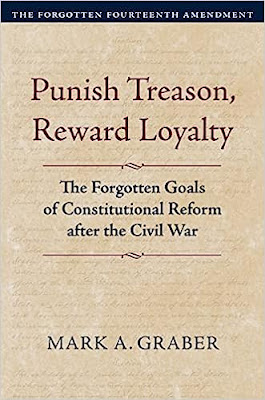
Mark A. Graber, Punish Treason, Reward Loyalty: The Forgotten Goals of Constitutional Reform after the Civil War (University of Kansas Press, 2023)
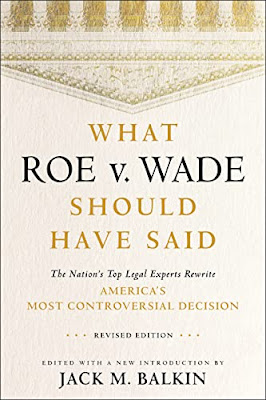
Jack M. Balkin, What Roe v. Wade Should Have Said: The Nation's Top Legal Experts Rewrite America's Most Controversial Decision - Revised Edition (NYU Press, 2023)

Andrew Koppelman, Burning Down the House: How Libertarian Philosophy Was Corrupted by Delusion and Greed (St. Martin’s Press, 2022)

Gerard N. Magliocca, Washington's Heir: The Life of Justice Bushrod Washington (Oxford University Press, 2022)
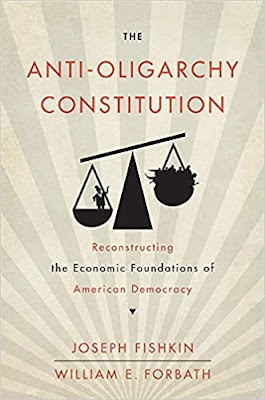
Joseph Fishkin and William E. Forbath, The Anti-Oligarchy Constitution: Reconstructing the Economic Foundations of American Democracy (Harvard University Press, 2022)
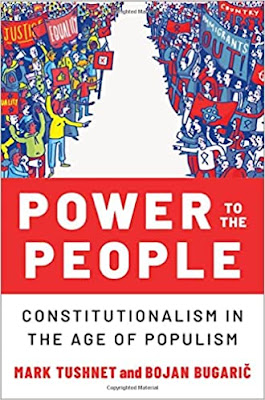
Mark Tushnet and Bojan Bugaric, Power to the People: Constitutionalism in the Age of Populism (Oxford University Press 2021).

Mark Philip Bradley and Mary L. Dudziak, eds., Making the Forever War: Marilyn B. Young on the Culture and Politics of American Militarism Culture and Politics in the Cold War and Beyond (University of Massachusetts Press, 2021).

Jack M. Balkin, What Obergefell v. Hodges Should Have Said: The Nation's Top Legal Experts Rewrite America's Same-Sex Marriage Decision (Yale University Press, 2020)

Frank Pasquale, New Laws of Robotics: Defending Human Expertise in the Age of AI (Belknap Press, 2020)

Jack M. Balkin, The Cycles of Constitutional Time (Oxford University Press, 2020)

Mark Tushnet, Taking Back the Constitution: Activist Judges and the Next Age of American Law (Yale University Press 2020).

Andrew Koppelman, Gay Rights vs. Religious Liberty?: The Unnecessary Conflict (Oxford University Press, 2020)

Ezekiel J Emanuel and Abbe R. Gluck, The Trillion Dollar Revolution: How the Affordable Care Act Transformed Politics, Law, and Health Care in America (PublicAffairs, 2020)

Linda C. McClain, Who's the Bigot?: Learning from Conflicts over Marriage and Civil Rights Law (Oxford University Press, 2020)
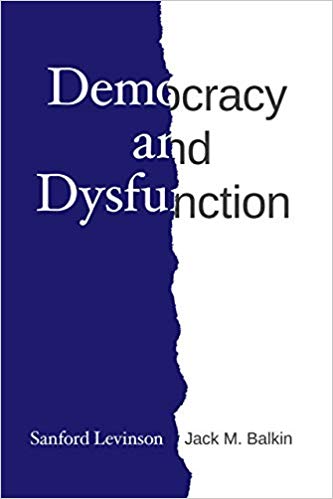
Sanford Levinson and Jack M. Balkin, Democracy and Dysfunction (University of Chicago Press, 2019)

Sanford Levinson, Written in Stone: Public Monuments in Changing Societies (Duke University Press 2018)

Mark A. Graber, Sanford Levinson, and Mark Tushnet, eds., Constitutional Democracy in Crisis? (Oxford University Press 2018)

Gerard Magliocca, The Heart of the Constitution: How the Bill of Rights became the Bill of Rights (Oxford University Press, 2018)

Cynthia Levinson and Sanford Levinson, Fault Lines in the Constitution: The Framers, Their Fights, and the Flaws that Affect Us Today (Peachtree Publishers, 2017)

Brian Z. Tamanaha, A Realistic Theory of Law (Cambridge University Press 2017)

Sanford Levinson, Nullification and Secession in Modern Constitutional Thought (University Press of Kansas 2016)

Sanford Levinson, An Argument Open to All: Reading The Federalist in the 21st Century (Yale University Press 2015)

Stephen M. Griffin, Broken Trust: Dysfunctional Government and Constitutional Reform (University Press of Kansas, 2015)

Frank Pasquale, The Black Box Society: The Secret Algorithms That Control Money and Information (Harvard University Press, 2015)

Bruce Ackerman, We the People, Volume 3: The Civil Rights Revolution (Harvard University Press, 2014)
Balkinization Symposium on We the People, Volume 3: The Civil Rights Revolution

Joseph Fishkin, Bottlenecks: A New Theory of Equal Opportunity (Oxford University Press, 2014)

Mark A. Graber, A New Introduction to American Constitutionalism (Oxford University Press, 2013)

John Mikhail, Elements of Moral Cognition: Rawls' Linguistic Analogy and the Cognitive Science of Moral and Legal Judgment (Cambridge University Press, 2013)

Gerard N. Magliocca, American Founding Son: John Bingham and the Invention of the Fourteenth Amendment (New York University Press, 2013)

Stephen M. Griffin, Long Wars and the Constitution (Harvard University Press, 2013)

Andrew Koppelman, The Tough Luck Constitution and the Assault on Health Care Reform (Oxford University Press, 2013)

James E. Fleming and Linda C. McClain, Ordered Liberty: Rights, Responsibilities, and Virtues (Harvard University Press, 2013)
Balkinization Symposium on Ordered Liberty: Rights, Responsibilities, and Virtues

Andrew Koppelman, Defending American Religious Neutrality (Harvard University Press, 2013)

Brian Z. Tamanaha, Failing Law Schools (University of Chicago Press, 2012)

Sanford Levinson, Framed: America's 51 Constitutions and the Crisis of Governance (Oxford University Press, 2012)

Linda C. McClain and Joanna L. Grossman, Gender Equality: Dimensions of Women's Equal Citizenship (Cambridge University Press, 2012)

Mary Dudziak, War Time: An Idea, Its History, Its Consequences (Oxford University Press, 2012)

Jack M. Balkin, Living Originalism (Harvard University Press, 2011)

Jason Mazzone, Copyfraud and Other Abuses of Intellectual Property Law (Stanford University Press, 2011)

Richard W. Garnett and Andrew Koppelman, First Amendment Stories, (Foundation Press 2011)

Jack M. Balkin, Constitutional Redemption: Political Faith in an Unjust World (Harvard University Press, 2011)

Gerard Magliocca, The Tragedy of William Jennings Bryan: Constitutional Law and the Politics of Backlash (Yale University Press, 2011)

Bernard Harcourt, The Illusion of Free Markets: Punishment and the Myth of Natural Order (Harvard University Press, 2010)

Bruce Ackerman, The Decline and Fall of the American Republic (Harvard University Press, 2010)
Balkinization Symposium on The Decline and Fall of the American Republic

Ian Ayres. Carrots and Sticks: Unlock the Power of Incentives to Get Things Done (Bantam Books, 2010)

Mark Tushnet, Why the Constitution Matters (Yale University Press 2010)
Ian Ayres and Barry Nalebuff: Lifecycle Investing: A New, Safe, and Audacious Way to Improve the Performance of Your Retirement Portfolio (Basic Books, 2010)
.jpg)
Jack M. Balkin, The Laws of Change: I Ching and the Philosophy of Life (2d Edition, Sybil Creek Press 2009)

Brian Z. Tamanaha, Beyond the Formalist-Realist Divide: The Role of Politics in Judging (Princeton University Press 2009)
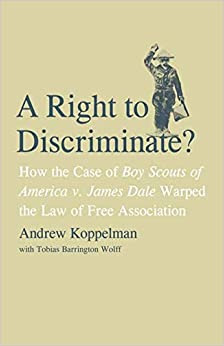
Andrew Koppelman and Tobias Barrington Wolff, A Right to Discriminate?: How the Case of Boy Scouts of America v. James Dale Warped the Law of Free Association (Yale University Press 2009)

Jack M. Balkin and Reva B. Siegel, The Constitution in 2020 (Oxford University Press 2009)
Heather K. Gerken, The Democracy Index: Why Our Election System Is Failing and How to Fix It (Princeton University Press 2009)

Mary Dudziak, Exporting American Dreams: Thurgood Marshall's African Journey (Oxford University Press 2008)

David Luban, Legal Ethics and Human Dignity (Cambridge Univ. Press 2007)

Ian Ayres, Super Crunchers: Why Thinking-By-Numbers is the New Way to be Smart (Bantam 2007)

Jack M. Balkin, James Grimmelmann, Eddan Katz, Nimrod Kozlovski, Shlomit Wagman and Tal Zarsky, eds., Cybercrime: Digital Cops in a Networked Environment (N.Y.U. Press 2007)
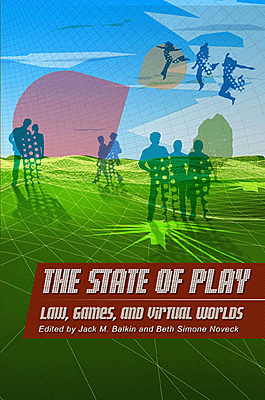
Jack M. Balkin and Beth Simone Noveck, The State of Play: Law, Games, and Virtual Worlds (N.Y.U. Press 2006)

Andrew Koppelman, Same Sex, Different States: When Same-Sex Marriages Cross State Lines (Yale University Press 2006)
Brian Tamanaha, Law as a Means to an End (Cambridge University Press 2006)
Sanford Levinson, Our Undemocratic Constitution (Oxford University Press 2006)
Mark Graber, Dred Scott and the Problem of Constitutional Evil (Cambridge University Press 2006)
Jack M. Balkin, ed., What Roe v. Wade Should Have Said (N.Y.U. Press 2005)
Sanford Levinson, ed., Torture: A Collection (Oxford University Press 2004)
Balkin.com homepage
Bibliography
Conlaw.net
Cultural Software
Writings
Opeds
The Information Society Project
BrownvBoard.com
Useful Links
Syllabi and Exams